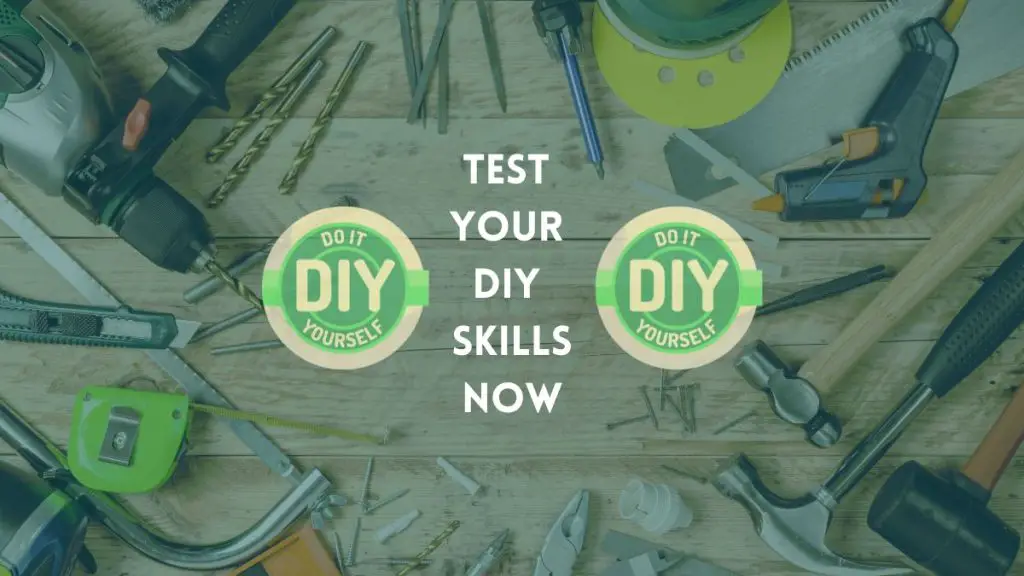Test your DIY skills by taking on small home projects. These tasks can reveal your strengths and areas for improvement.
DIY projects are a fantastic way to enhance your skills while saving money. Simple tasks like painting a room, fixing a leaky faucet, or assembling furniture can boost your confidence. You will also gain hands-on experience and learn new techniques.
Start with small projects to build your toolkit and knowledge base. These efforts can make your living space more personalized and functional. Plus, completing projects on your own provides a sense of accomplishment. DIY activities also encourage creativity and problem-solving. Dive into your next project to test and refine your DIY abilities.

Related Article: Basic DIY Skills Every Homeowner Should Know About It
Embarking On Your DIY Journey
Starting a DIY project can be exciting. You get to create something unique. This journey will enhance your skills. You will also gain confidence. Let’s dive into this adventure step by step.
Identifying Your Project
First, choose a project you love. It could be small or big. Make sure it excites you. Here’s a list of simple project ideas:
- Painting a room
- Building a bookshelf
- Creating wall art
- Refurbishing old furniture
Choose a project that matches your skills. Don’t start with something too hard. This way, you won’t get frustrated. Enjoy the process and learn as you go.
Gathering Your Tools
Next, gather your tools. You need the right tools for the job. Here’s a basic tool list:
| Tool | Purpose |
|---|---|
| Hammer | For nails and assembling |
| Screwdriver | Tightening screws |
| Paintbrush | Applying paint |
| Tape Measure | Measuring dimensions |
| Level | Ensuring straight lines |
Make sure your tools are in good condition. Clean and maintain them regularly. This will make your work easier and safer.
Step-by-step Guide To Your First Project
Are you ready to test your DIY skills? This guide helps you start your first project with confidence. Follow these steps to succeed.
Breaking Down The Process
Planning is the most important step. Gather all your materials first. Use a checklist:
- Tools: Hammer, screwdriver, tape measure
- Materials: Wood, nails, screws
- Safety Gear: Gloves, goggles
Next, prepare your workspace. Clear out clutter and ensure good lighting. Follow these steps:
- Read the instructions carefully.
- Measure your materials.
- Cut and assemble as needed.
Troubleshooting Common Issues
Sometimes, things might go wrong. Here are some common issues and solutions:
| Issue | Solution |
|---|---|
| Parts don’t fit | Check your measurements again. |
| Loose screws | Use a longer screw or wood glue. |
| Crooked assembly | Use a level to straighten. |
Remember, patience is key. Take your time and enjoy the process.
Maximizing Limited Resources
Embarking on a DIY project can be incredibly rewarding. But what if you have limited resources? This guide will help you maximize what you have, making your DIY efforts both cost-effective and creative.
Creative Material Substitutions
Running out of specific materials? No problem. Here are some creative substitutions:
- Cardboard can replace wood for lightweight structures.
- Use old newspapers for papier-mâché projects.
- Transform plastic bottles into plant pots or storage containers.
- Repurpose fabric scraps for quilting or patchwork.
Think outside the box. Everyday items can serve new purposes. This approach not only saves money but also reduces waste.
Making The Most Of Your Space
Limited space shouldn’t limit your creativity. Here are some space-saving tips:
- Vertical storage: Use shelves and hooks to utilize wall space.
- Invest in foldable furniture that can be stored away when not in use.
- Create a portable workstation with wheels for flexibility.
- Use multi-functional tools to save space and money.
Organize your workspace. A clutter-free area enhances productivity and creativity. Consider using a pegboard to keep tools and materials within easy reach.
Remember, the goal is to make your DIY projects enjoyable and efficient, even with limited resources. Happy crafting!

Enhancing Your Skills With Online Resources
Testing your DIY skills can be fun and rewarding. The internet is full of resources to help you get better at DIY projects. From blogs to video tutorials, you can find everything you need online.
Top DIY Blogs And Websites
Many DIY blogs and websites offer step-by-step guides. These guides cover a wide range of projects. You can find ideas for home decor, furniture building, and more.
Here are some popular DIY blogs and websites:
- DIY Network: Offers a variety of projects and tips.
- Instructables: Features user-submitted tutorials for all skill levels.
- Apartment Therapy: Focuses on home improvement and design ideas.
- Makezine: Perfect for tech enthusiasts and creative minds.
- Craftsy: Great for arts and crafts projects.
Leveraging Video Tutorials
Video tutorials make learning new DIY skills easier. Platforms like YouTube have countless videos on various projects. You can see the process in action and follow along.
Here are some top YouTube channels for DIY projects:
- This Old House: Focuses on home renovation and repair.
- DIY Creators: Offers creative and functional projects.
- House Improvements: Provides detailed home improvement tutorials.
- 5-Minute Crafts: Features quick and easy DIY ideas.
- Home Repair Tutor: Specializes in home repair and maintenance tips.
Watching these videos can help you understand the steps better. You can pause, rewind, and re watch as needed. This makes it easier to follow and learn at your own pace.
Showcasing And Sharing Your Creations
You’ve completed a fantastic DIY project. Now, it’s time to show the world! Showcasing and sharing your creations is a great way to get feedback and inspire others. Let’s explore some effective ways to present your work.
Photographing Your Work
Good photos make your creations stand out. Use natural light for the best results. Avoid direct sunlight to prevent harsh shadows.
- Use a clean background: It keeps the focus on your work.
- Multiple angles: Show every detail of your creation.
- High resolution: Clear photos look more professional.
Remember, a picture is worth a thousand words. Make each one count!
Utilizing Social Media
Social media platforms are perfect for sharing your DIY projects. Each platform has its strengths.
| Platform | Best For |
|---|---|
| High-quality photos and short videos. | |
| Detailed posts and community engagement. | |
| Inspiration and ideas sharing. | |
| YouTube | Step-by-step tutorials. |
- Engage with your audience: Reply to comments and messages.
- Use relevant hashtags: Increase the reach of your posts.
- Post consistently: Keep your audience engaged.
Social media helps you connect with a wider audience. Share your creativity and inspire others!
3 Simple Inventions | Test Your DIY skills>>
Conclusion
Testing your DIY skills can be both rewarding and educational. Embrace new challenges and enhance your creativity. Regular practice will improve your expertise. Remember, patience and persistence are key. Share your projects and inspire others. Happy crafting!
Related Article: The Ultimate Guide to Solid Roof Pergolas
You may also read: 16 Ways to Make Your Home Better



